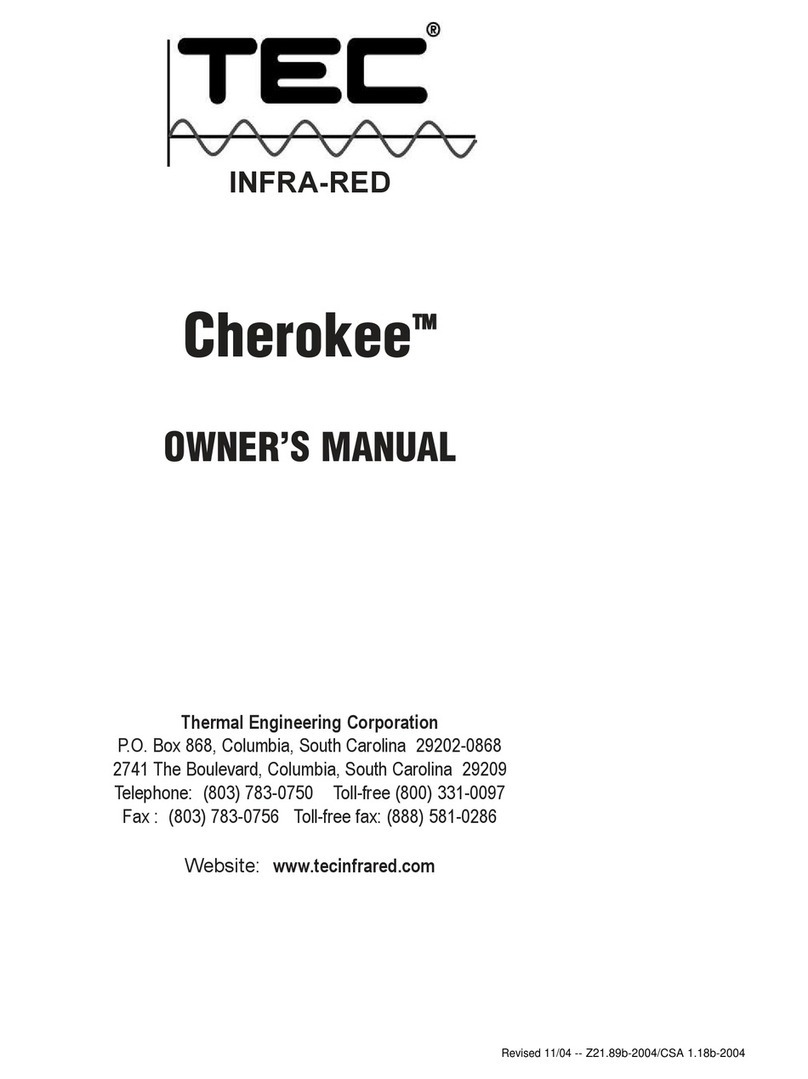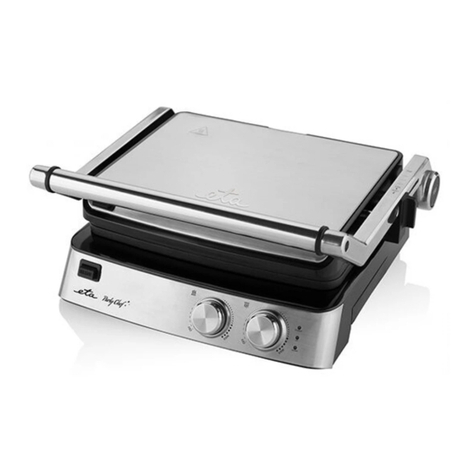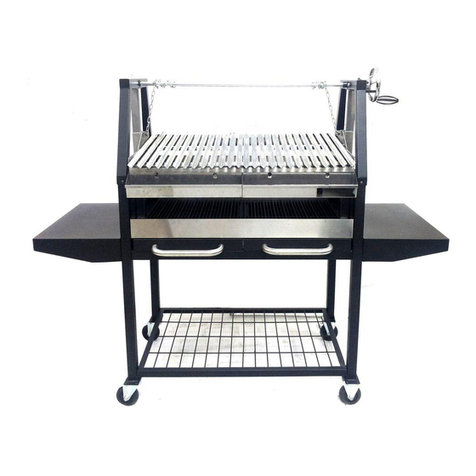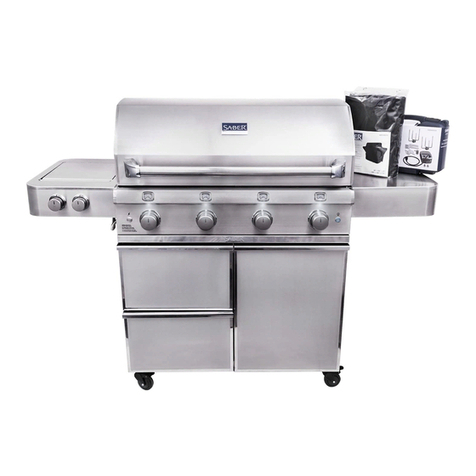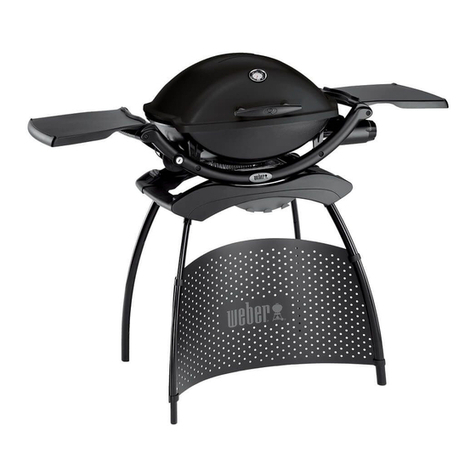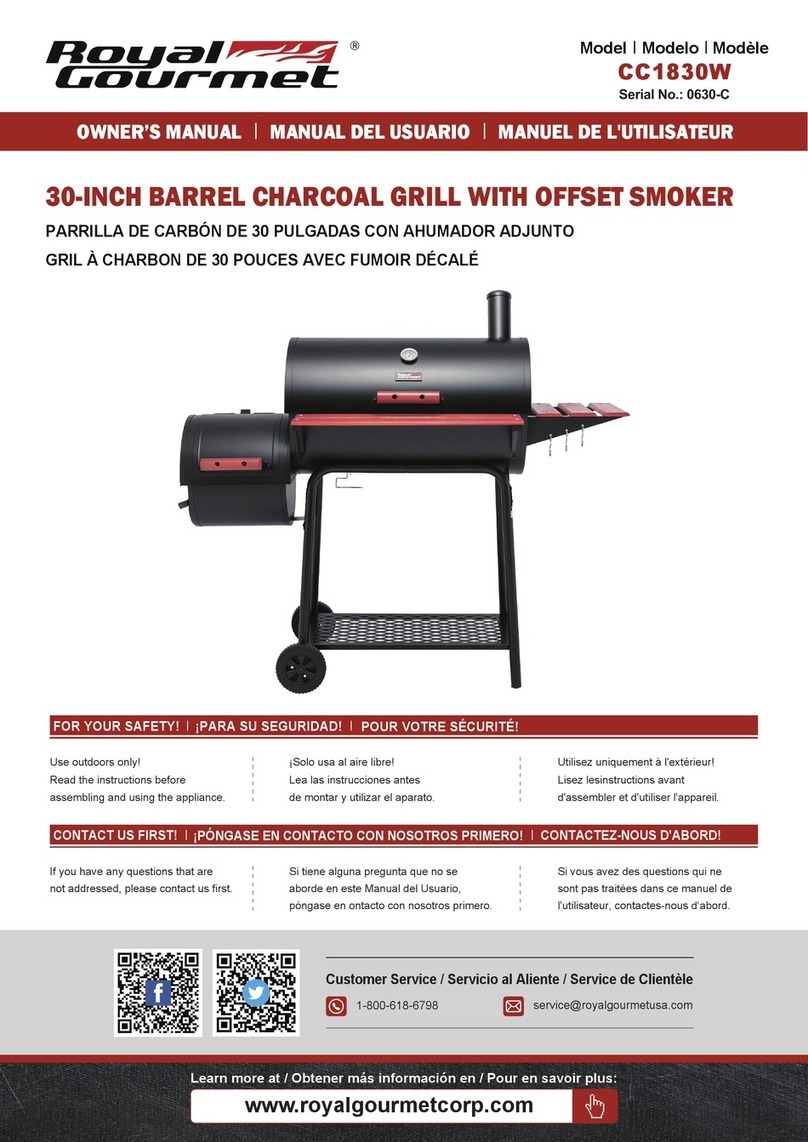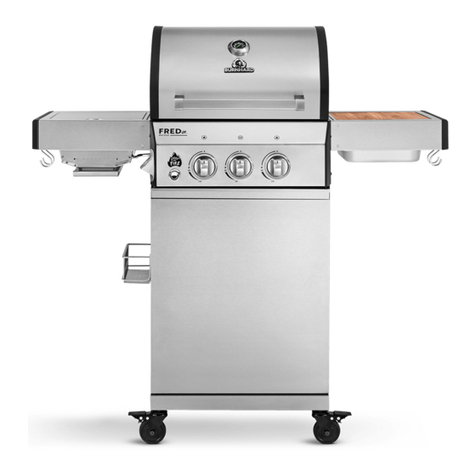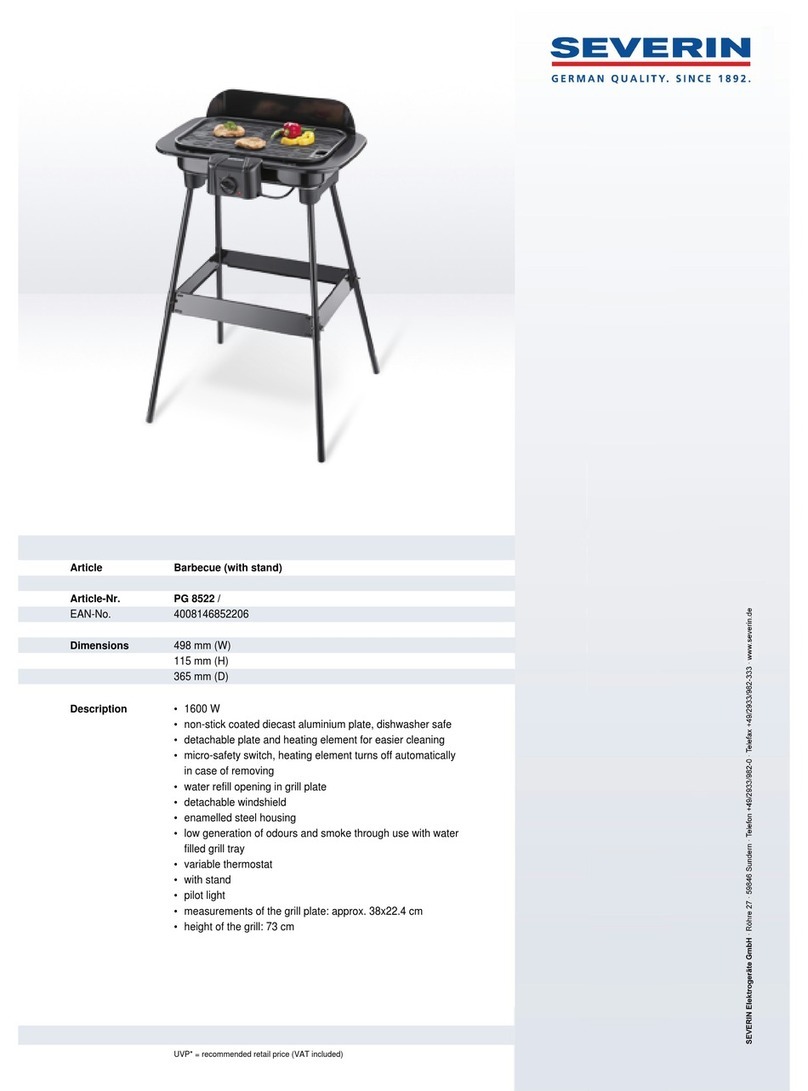TEC Infra-red STERLING User manual

INFRA-RED
Sterling
®
OWNER’S MANUAL
Thermal Engineering Corporation
P.O. Box 868, Columbia, South Carolina 29202-0868
2741 The Boulevard, Columbia, South Carolina 29209
Telephone: (803) 783-0750 Toll-free (800) 331-0097
Fax : (803) 783-0756 Toll-free fax: (888) 581-0286
Website: www.tecinfrared.com

1
Notice to Customer
PRIOR TO INSTALLING AND USING THIS APPLIANCE,
READ THIS MANUAL FULLY AND CAREFULLY. RETAIN
THIS MANUAL FOR FUTURE REFERENCE AND HAVE
AVAILABLE AT ALL TIMES. ENSURE THAT ALL
PERSONS OPERATING THIS EQUIPMENT CAREFULLY
READ AND BECOME FAMILIAR WITH THE
INFORMATION IN THIS MANUAL.
THIS UNIT HAS BEEN CAREFULLY INSPECTED AND
PACKAGED AT THE FACTORY PRIOR TO SHIPMENT.
UPON ARRIVAL, INSPECT THE APPLIANCE
CAREFULLY FOR ANY CONCEALED DAMAGE.
IMMEDIATELY REPORT ANY DAMAGE TO YOUR
AUTHORIZED DEALER.
SHOULD YOU HAVE ANY QUESTIONS REGARDING
OPERATION OR USE OF THIS APPLIANCE, CONTACT
THERMAL ENGINEERING CORPORATION AT
(803) 783-0750 OR 1-800-331-0097.
Notice to Installer
INSTALLATION MUST CONFORM TO LOCAL CODES OR
THE NATIONAL FUEL GAS CODE, ANSI Z223.1/NFPA 54.
IN CANADA, INSTALLATION OF THIS PRODUCT
SHOULD BE IN ACCORDANCE WITH THE CAN/CGA-
B149.1 NATURAL GAS AND PROPANE INSTALLATION
CODE. FOLLOWING INSTALLATION, LEAVE THIS
OPERATIONS MANUAL WITH THE CONSUMER FOR
FUTURE REFERENCE. THIS APPLIANCE IS NOT
INTENDED FOR USE ON RECREATIONAL VEHICLES
AND/OR BOATS.
FOR YOUR SAFETY
IF YOU SMELL GAS:
1. SHUT OFF GAS TO THE APPLIANCE.
2. EXTINGUISH ANY OPEN FLAME.
3. OPEN LID.
4. IF ODOR CONTINUES, IMMEDIATELY CALL YOUR
GAS SUPPLIER OR YOUR FIRE DEPARTMENT.
FOR YOUR SAFETY
1. DO NOT STORE OR USE GASOLINE OR OTHER
FLAMMABLE VAPORS OR LIQUIDS IN THE
VICINITY OF THIS OR ANY OTHER
APPLIANCE.
2. AN LP CYLINDER NOT CONNECTED FOR USE
SHALL NOT BE STORED IN THE VICINITY OF
THIS OR ANY OTHER APPLIANCE.
Warnings Notices
Warnings to Customer
DO NOT INSTALL OR OPERATE THIS APPLIANCE
WITHOUT HAVING CAREFULLY READ THIS MANUAL.
FOR FUTURE REFERENCE, HAVE THIS MANUAL
AVAILABLE WHILE USING THIS APPLIANCE AND
ALWAYS FOLLOW THE INSTRUCTIONS PROVIDED.
NEVER ATTEMPT TO MAKE CONVERSIONS OR
MODIFICATIONS TO YOUR GRILL WITHOUT FIRST
OBTAINING WRITTEN INSTRUCTIONS FROM THERMAL
ENGINEERING CORPORATION.
DO NOT STORE A SPARE GAS CYLINDER UNDER OR
WITHIN 15 FEET OF THIS GRILL, ANY OTHER OPEN
FLAME, HEAT PRODUCING APPLIANCE OR HEAT
SOURCE. FAILURE TO FOLLOW THESE INSTRUCTIONS
CAN RESULT IN A FIRE CAUSING DEATH OR SERIOUS
INJURY OR PROPERTY DAMAGE.
DO NOT ALLOW YOUR LP GAS CYLINDER TO BE FILLED
BEYOND 3/4FULL.
NATIONALLY REGISTERED TESTING LABORATORY
U.S. Patent # 4886044
U.S. Patent # 4321857
Des. 266,050
© Thermal Engineering Corporation
Revision (08/04)

Lifetime Limited Warranty
2Revised 08/04
EXPRESS WARRANTIES
Thermal Engineering Corporation (TEC) warrants this grill to be free of defects in material and
workmanship when subjected to normal domestic use and service from the date of purchase.
LIFETIME
All stainless steel components other than cooking grids and stainless steel burner components are
warranted indefinitely. This includes the hood, cooking unit structure, side-shelf, pedestal and cabinet.
TEN (10) YEARS
All components not covered by the lifetime warranty above are warranted for ten (10) years.
UNDER THIS WARRANTY
We will, at our option, repair or replace any component part deemed by TEC to be defective when
returned to the TEC factory, freight prepaid, within the warranty period. Prior to authorization of
repair or replacement, you must supply the date of original purchase and serial number of your grill.
This warranty excludes damage caused by failure to follow the instructions in your Owner’s Manual or
alteration of the grill’s structure or components, or from operator abuse, negligence or accident.
DISCLAIMER OF IMPLIED WARRANTIES
This warranty excludes incidental and consequential damages. Except as stated above, all other
warranties, including implied warranties of merchantability and fitness for a particular purpose, are
excluded.
If you have questions concerning this warranty, please call your local authorized TEC dealer or call us
at (803) 783-0750 or 1-800-331-0097.
MODEL #:
SERIAL #:
(See rating plate found under Drip Tray, back right corner of grill.)
DEALER NAME:
DEALER TELEPHONE:
(Complete the above information for future reference.)
T
HERMAL
E
NGINEERING
C
ORPORATION
P.O. Box 868, Columbia, South Carolina 29202-0868
2741 The Boulevard, Columbia, South Carolina 29209
Telephone: (803) 783-0750 Toll-free (800) 331-0097
Facsimile: (803) 783-0756 Toll-free (888) 581-0286
Website: www.tecinfrared.com

3
Dear TEC Infra-Red Grill Owner:
Congratulations on selecting a TEC Infra-Red as your grill of choice. You’re among a select group
who truly appreciate fine cooking and demand the best.
I know you’ll be pleased with your grill’s performance.
Over the years, we’ve invested great resources in developing a grill that’s truly unique — from the
sturdy, long-lasting construction to the unparalleled infra-red cooking process. But I’m sure that’s why
you selected a TEC grill over all others. You must have seen that our commitment to quality and
innovation would provide you with years of satisfying use.
We’ve developed this manual to give you an overview of your grill and to help you get the most from
it. We’ve included some cooking guidelines for you to use until you develop your own techniques.
We’ve also included vital information about how to set up, operate and maintain your grill safely and
correctly, so I urge you to read it carefully before first using your grill. If, after reviewing this
information, you have any questions whatsoever, please call your Authorized TEC Dealer or our
Customer Service Department for help.
As I’m sure you know, we also offer a complete line of accessories that afford you a wide range of
opportunities for new and interesting uses of your grill. Some of them, like our rotisserie, are options
familiar to everyone. Others, like our deep fryer and wok, are truly unique enhancements that allow
you to be adventuresome and inventive with your grill. Your dealer can tell you more about all the
accessories we offer and their many uses.
If you have comments, suggestions, or even compliments, please pass them along to us. We are
continually in search of ways we can improve our customers’ experiences with their grills, starting
when they first remove them from the box and continuing as they use them over the years. Hearing
what you feel we could improve, as well as what you especially like about our products and services, is
essential to this effort. I hope you’ll agree that the product registration form is a convenient, easy way
to accomplish this.
Thanks for selecting TEC — I wish you years of great grilling!
Best regards,
THERMAL ENGINEERING CORPORATION
W.H. “Bill” Best
Chairman and CEO

4Revised 08/04
Installation..................................................4
General Overview
Permanent Installation
Assembly ....................................................5
General Overview
Tools Required
Side-shelf
Pedestal Base
In-ground Post Base and Bolt-down Post Base
Cabinet Base
Roll Back Hood
Cooking Grids and Baking Rack
Gas Connection......................................................8
General Overview
LP Gas Cylinder Safety
Installing Your LP Gas Cylinder
Removing Your LP Gas Cylinder
Quick Disconnect Instructions
Permanent Installation
Gas Leak Test
Operation............................................................11
General Overview
Burner Ignition
Burner Ignition Without Pilot
Low Heat Adjustment
Pilot Flame Adjustment
Base Brake
Hazardous Locations and Conditions
Infra-red Cooking ..................................................14
General Overview
Infra-red Searing Method
Helpful Hints in Cooking
Flame Flare-up Control
Sample Cooking Methods
Maintenance and Cleaning ......................................16
General Overview
Protection of Burners
Cleaning
Maintenance
Replacement Parts
Appendix A: Build-in Specifications............................18
Appendix B: Accessories ........................................20
Rotisserie
Bar-B-Que Tray
Wood Chip Smoker
Deep Fryer/Steamer
Griddle
Wok
Sterling®Side-burner
Appendix C - Replacement Parts................................28
Appendix D - Troubleshooting ..................................29
General Overview
WARNING: THIS GRILL IS DESIGN CERTIFIED FOR USE
OUTDOORS ONLY.
THIS GRILL SHOULD NOT BE USED IN A BUILDING,
GARAGE OR OTHER ENCLOSED AREA AND IS NOT
INTENDED FOR USE ON RECREATIONAL VEHICLES OR
BOATS.
The Sterling®is designed for permanent installation on a
free-standing masonry or other suitable patio fixture. See
Appendix A for complete build-in specifications.
The Sterling can also be attached to the optional pedestal
or cabinet base, which have casters for easy movement. It
can be locked in place by using the brake mechanism,
WHICH SHOULD BE ENGAGED AT ALL TIMES
located near
the back left corner of the pedestal base or inside the
cabinet base at the back left corner. (See
BASE BRAKE
section on page 13 for more information.)
Figure 1 (see page 5) represents the minimum clearance
of a mobile grill to any adjacent combustible
construction.
WARNING: THIS OUTDOOR COOKING GAS APPLIANCE
SHALL NOT BE USED UNDER OVERHEAD
COMBUSTIBLE CONSTRUCTION.
Permanent Installation
If you are installing your grill as a build-in or on the
optional Post Base (Sterling II only), it should be located
so the ventilation louvers remain clear of all obstructions.
The louvers are located in the front surface of the Grill’s
Housing and at the rear of the Roll Back Hood. Any
accumulation of debris will restrict the flow of
combustion and/or ventilation air, and may result in
improper burner operation or overheating. See Table A.1
for clearance specifications. Installation procedures
relating to gas connections for permanent installations
can be found in the Gas Connection section of this
manual. Build-in opening specifications can be found in
Appendix A of this manual.
Table A.1 Clearance Specifications
COMBUSTIBLE NON-COMBUSTIBLE
CONSTRUCTION CONSTRUCTION
Sides 12" 0"
Back 12" 0"
Contents Installation

5
The Post Base (Sterling II only) is designed to be installed
in a bed of concrete to a depth of 17
1
/
2
". The height of
the grill cooking surface should be roughly 38
1
/
2
" from
the ground. (See Figure 4 & 5.) The line gas connection
is located on the left side of the post. The gas connection
is SAE 45° female flare.
The Post Base is constructed of stainless steel, which is
highly corrosion resistant. However, a suitable means of
corrosion protection should be used, as necessary, due to
corrosion conditions at the installation site.
The installation of your grill must conform to local codes
or, in absence of local codes, the National Fuel Gas Code
ANSI Z223.1/NFPA 54. In Canada, the installation
must conform to local codes and/or the Natural Gas and
Propane Installation Code CAN/CGA-B149.1.
Figure 1. Clearance To Combustible Construction
WARNING: THIS OUTDOOR COOKING GAS APPLIANCE
SHALL NOT BE USED UNDER OVERHEAD
COMBUSTIBLE CONSTRUCTION.
General Overview
Sterling grills are designed for easy assembly. Both the
Sterling II and Sterling III are available with assembled
hood. You can choose from our optional bases and side-
shelves to customize your grill. Assembly procedures for
each of these options follow.
Tools Required
■Flat head screwdriver
■Phillips screwdriver (#2)
■Ratchet with
7
/
16
" socket or
7
/
16
" end wrench
Side-shelf
1. Use the four (4)
1
/
4
- 20 x
1
/
2
"L Phillips-head screws
from the plastic bag that contained this Owner’s
Manual and the TEC®Cookbook.
2. Thread two (2) Phillips-head screws approximately
1
/
4
" into the two (2) top threaded holes of the grill
side panel.
3. Using the keyholes on the Side-shelf, place the Side-
shelf on the
1
/
4
" screws. Ensure that the screws slide
to the top of the keyhole slots.
4. Tighten the two (2) top screws until the Side-shelf is
flush but not tight against the grill side panel of the
Sterling gas grill.
5. Connect the remaining two (2) screws through the
Side-shelf and into the bottom two (2) threaded
holes of the grill side panel.
6. Tighten all four (4) screws firmly.
Figure 2. Side-shelf Attachment
Installation continued Assembly

Revised 08/04
6
Pedestal Base (Sterling II and III)
1. Remove the Pedestal Base from the packaging
materials and set it on a level surface.
2. Place the Grill Housing on the Pedestal Base and
align the round mounting holes in the Base with the
threaded inserts in the Housing.
3. Fasten the Housing to the Base with the supplied
hardware. (Hardware needed: Four (4) each
1
/
4
- 20 x
1
/
2
"L hex head bolts and flat washers.) (See Figure 3.)
Figure 3. Pedestal Base
In-ground Post Base and Bolt-down Post Base
(Sterling II Only)
1. Install the In-ground or Bolt-down Post Base in
accordance with the instructions accompanying Post
Base.
2. Fasten the Housing to the Base with the supplied
hardware. (Hardware needed: Four (4) each
1
/
4
- 20
x
1
/
2
L hex head bolts and flat washers.) (See Figures
4 & 5.)
Figure 4. In-ground Post (Sterling II Only)
Figure 5. Bolt-down Post (Sterling II Only)
Assembly continued
261/2"
171/2"
21/2"
GROUND
1/4 - 20 HEX. BOLT
W/ FLAT WASHER
(TYP. BOTH ENDS)
1/4 - 20 HEX. BOLT
W/ FLAT WASHER
(TYP. BOTH ENDS)

7
Cabinet Base (Sterling II and III)
1. Remove the Cabinet Base from the packaging
materials and set it on a level surface.
2. Place the Grill Housing on the Cabinet Base and
align the round mounting holes in the Base with the
threaded inserts in the Housing.
3. Fasten the Housing to the Base with the supplied
hardware. (Hardware needed: Four (4) each
1
/
4
-20 x
1
/
2
"L hex head bolts and flat washers.) (See Figure 6.)
Figure 6. Cabinet Base
Roll Back Hood (Sterling II and III)
1. Remove the Roll Back Hood from the packaging
materials.
2. Remove the Heat Shield from the Grill Housing.
(See Figure 7.)
3. Set the Hood in place on the Grill Housing.
4. Fasten the Hood to the Grill Housing with the
supplied hardware. (Hardware needed: Four (4) each
#10-24 x
1
/
2
"L screws and nuts.) (See Figure 8.)
5. Replace the Heat Shield.
Cooking Grids and Baking Rack
(Sterling II and III)
1. Remove the Cooking Grids and Baking Rack from
the packaging materials.
2. Set the Cooking Grids in place with the open side of
the channels facing up and the holes toward the rear
of the grill. Set the Baking Rack in place inside the
Roll Back Hood.
Assembly continued
1/4 - 20 HEX. BOLT
W/ FLAT WASHER
(TYP. BOTH ENDS)
10-24 SCREW
W/ #10 KEP NUT
(TYP. BOTH ENDS)
HEAT SHIELD
Figure 7. Heat Shield
Figure 8. Roll Back Hood

Revised 08/04
8
Gas Connection
General Overview
WARNING: THE GAS SUPPLY HOSE SHOULD BE
INSPECTED PRIOR TO EACH USE. DO NOT USE A GAS
HOSE THAT HAS ABRASION, CUTS OR EXCESSIVE
WEAR. IF ABRASION, CUTS OR EXCESSIVE WEAR IS
EVIDENT, THE GAS SUPPLY HOSE MUST BE REPLACED
BEFORE USE. REPLACEMENT ASSEMBLY MUST BE
SPECIFIED BY TEC.
WARNING: WHEN YOUR GRILL IS STORED INDOORS,
REMOVE AND STORE THE LP GAS CYLINDER
OUTDOORS IN A PROTECTED, COOL AND DRY
LOCATION OUT OF REACH OF CHILDREN. THE
CYLINDER SHOULD NOT BE STORED IN A BUILDING,
GARAGE OR ANY OTHER ENCLOSED AREA.
Follow the procedures outlined in this section closely to
ensure safe and proper grill operation. The Sterling grill is
offered in one of two gas configurations: LP or Natural
gas. The pressure regulator and hose used for the LP gas
configuration varies depending on the type of base used.
Reference Table A.2 below for regulator specifications.
Grills that do not use LP gas with standard 20 lb. LP
cylinder must be installed by qualified personnel. This
includes all Natural gas and permanently installed units.
Gas regulators specified by TEC should be used at all
times.
PLEASE NOTE: When any burner using propane fuel
exceeds the capacity of the propane cylinder to vaporize
the fuel, the cylinder pressure can decrease to the extent
that the appliance will not burn properly.
Refer to Table A.2 below for gas supply specifications or
see rating plate located at the grill’s right rear corner
below Drip Tray.
LP Gas Cylinder Safety
WARNING: WHEN PURCHASED FOR USE WITH LP
GAS, THE STERLING GRILL COMES WITH A
REGULATOR ASSEMBLY THAT USES A TYPE I CYLINDER
CONNECTION DEVICE. THIS DEVICE SHOULD ONLY BE
USED WITH A TYPE I TANK VALVE CYLINDER
CONNECTION.
NOTICE: AN LP GAS CYLINDER IS NOT PROVIDED
FROM THE FACTORY WITH THIS GRILL. HOWEVER,
ONLY APPROVED 20 LB. LP GAS CYLINDERS
CONSTRUCTED AND MARKED IN ACCORDANCE WITH
THE
SPECIFICATIONS FOR LP GAS CYLINDERS
OF
THE U.S. DEPARTMENT OF TRANSPORTATION (D.O.T)
OR NATIONAL STANDARD OF CANADA, CAN/CGA-B339,
CYLINDERS, SPHERES AND TUBES FOR THE
TRANSPORTATION OF DANGEROUS GOODS
;
AND
COMMISSION
, SHOULD BE USED. ALL APPROVED
CYLINDERS MUST BE EQUIPPED WITH AN INTEGRAL
COLLAR DESIGNED TO PROTECT THE CYLINDER
VALVE FROM DAMAGE, AS WELL AS A LISTED
OVERFILL PROTECTION DEVICE. DO NOT USE OR TRY
TO REPAIR A DAMAGED LP GAS CYLINDER AT ANY
TIME. CONTACT YOUR LOCAL LP GAS SUPPLIER FOR
REPLACEMENT. ALSO, YOU SHOULD ALWAYS
OBSERVE THE FOLLOWING PRECAUTIONS:
■Store spare or extra gas cylinders at least 15 feet from
this grill or other open flame, heat-producing
appliance or heat source.
■Do not fill your gas cylinder beyond
3
/
4
full.
■Gas cylinders come with a pressure relief valve. If a
cylinder is subjected to excess heat, the relief valve
will open and let highly flammable gas vapor and/or
liquid escape. Therefore, do not store gas cylinders
near an open flame or source of heat. Store cylinders
only in well ventilated areas.
WARNING: FAILURE TO FOLLOW THE ABOVE
PRECAUTIONS COULD RESULT IN A FIRE CAUSING
DEATH OR SERIOUS INJURY OR PROPERTY DAMAGE.
GAS, REGULATOR SUPPLY PRESSURE OPERATING PRESSURE MAIN BURNER BURNER OUTPUT
AND BASE TYPE (IN. WC (kPa), MAX/MIN) (IN. WC (kPa)) ORIFICE SIZE (DMS / DIA.) (BTU/HR. (W)/EA.)
Natural 14.0 (3.4)/5.0 (1.2) 4.0 (1.0) 46 (0.0810") 18,500 (5,422)
model RV-47L (NG)
stationary or post
LP 14.0 (3.4)/12.0 (3.0) 11.0 (2.7) 55 (0.0520") 18,500 (5,422)
model RV-47L (LP)
stationary or post
LP 125 psi (861), max 11.0 (2.7) 55 (0.0520") 18,500 (5,422)
model 150 w/ hose
pedestal or cabinet
Table A.2. Gas Supply Specifications

Installing Your LP Gas Cylinder
NOTICE: FOR YOUR SAFETY, ONLY USE THE
REGULATOR AND HOSE ASSEMBLY PROVIDED AS
ORIGINAL EQUIPMENT WITH YOUR GRILL.
REPLACEMENT ASSEMBLIES MUST ALSO BE SPECIFIED
BY TEC.
NOTICE: A FIRE EXTINGUISHER FOR CLASS A, B, C &
D FIRES SHOULD BE READILY AVAILABLE AT ALL TIMES.
WARNING: THE VENTILATION/ACCESS OPENING, IN
THE REAR OF THE PEDESTAL, MUST BE FREE AND
CLEAR FROM DEBRIS. THE GAS MUST BE TURNED OFF
AT THE SUPPLY CYLINDER WHEN THE GRILL IS NOT IN
USE.
Be sure to set the gas cylinder upright so the Cylinder
Valve is at the top. This will ensure proper vapor
withdrawal.
When you connect your cylinder to the grill, you will feel
the coupling nipple seal when there is slight resistance.
(See Figure 9.) Turn about one-half to three-quarters
further to complete the connection. Tighten only by hand;
do not use tools. If you cannot complete the final
connection, disconnect the regulator and repeat step 7,
below. If you are still unable to complete the connection,
replace the valve and regulator!
Procedure:
1. In order to make sure the Cylinder Valve is fully
closed, turn the Handwheel clockwise until it stops.
2. Turn all burner and pilot controls OFF.
3. Move your grill to an open area that’s level and
engage the Base Brake. (See Figure 17.)
4. Place the gas cylinder in the space provided in the
Base. Remove the protective caps from Cylinder
Valve Outlet and Nipple, as necessary.
5. Inspect the Coupling Nut, Nipple and Cylinder
Valve. See if there is any damage, dirt or debris.
Remove dirt or debris. Replace damaged parts prior
to use.
6. Inspect Regulator and Hose Assembly. See if there is
any damage, dirt or debris. Remove dirt or debris.
Replace damaged parts prior to use.
7. With the Regulator in your hand, insert the Nipple
into the Cylinder Valve. Make sure the Nipple is
centered in the Cylinder Valve outlet. Tighten the
Coupling Nut by hand, making sure not to cross-
thread the connection.
WARNING: KEEP THE VENTILATION OPENINGS OF
THE CYLINDER ENCLOSURE FREE AND CLEAR OF
DEBRIS.
9
Gas Connection continued
COUPLING
ASSEMBLY
FIGURE 9
INSET FIGURE
PROPANE TANK
RELEASE
CLOSE LATCH
TOP VIEW
Handwheel
Excess Flow
Valve
Cylinder
Valve
Cap & Strap
Valve
Outlet
Coupling
Nut
Regulator
Nipple
Figure 9. Coupling Assembly
Figure 10. Gas Tank Placement

Removing Your LP Gas Cylinder
Procedure:
1. Close the Cylinder Valve by turning the Handwheel
clockwise until it stops.
2. Release the latch and remove the cylinder from grill.
3. Loosen the Coupling Nut by turning it counter-
clockwise.
Quick Disconnect Instructions
(See Figure 11.)
Procedure:
1. To connect, push back Sleeve of Socket. (See Figure
A.)
2. Insert Plug (See Figure B.), release Sleeve.
3. Push Plug until Sleeve snaps forward locking Plug in
Socket (See Figure C.). (THIS AUTOMATICALLY
TURNS ON GAS.)
4. To disconnect, push sleeve back and pull out plug.
(THIS AUTOMATICALLY SHUTS OFF GAS.)
Permanent Installation
CAUTION: GAS PIPING TO YOUR GRILL MUST BE IN
ACCORDANCE WITH LOCAL CODES. IN THE ABSENCE
OF LOCAL CODES, USE THE NATIONAL FUEL GAS
CODE ANSI Z223.1/NFPA 54 (LATEST EDITION) OR
CAN/CGA B-149.1, NATURAL GAS AND PROPANE
INSTALLATION CODE.
CAUTION: THE GAS SUPPLY MUST BE TURNED OFF AT
THE GRILL WHEN THIS APPLIANCE IS NOT IN USE.
When ordered for use with Natural gas, the Sterling grill
comes adjusted to operate with Natural gas. Qualified
personnel should install the gas line. A Shut-off Valve at
the grill is required. This Valve must be design certified
by CSA International. When using the optional Post
Base, you must use the Regulator and separate hose
supplied with the Post Base. Specifications for gas supply
requirements are listed in Table A.2 on page 8.
The grill and Shut-off Valve must be disconnected from
the gas supply piping system during any pressure testing
of the system at test pressures in excess of
1
/
2
PSIG (3.5
kPa).
The grill must be isolated from the gas supply piping
system by closing its individual manual Shut-off Valve
during any pressure testing of the system at test pressures
equal to or less than
1
/
2
PSIG (3.5 kPa).
Gas Leak Test
WARNING: DO NOT USE OPEN FLAME TO PERFORM
LEAK TEST!
WARNING: DO NOT ATTEMPT TO USE THE GRILL
WHEN YOU SMELL GAS OR FAIL A GAS LEAK TEST.
Make sure there is no open flame near the grill during
the test. Test for leaks every time the gas connection is
disconnected.
Procedure:
1. Turn all controls OFF.
2. Open the Gas Supply Valve slowly. Apply soapy
water solution to all connections including factory
connections.
3. Look for bubbles around the connections. If bubbles
can be seen, close the Valve and tighten the
connection where the bubbles are. Then, repeat steps
1 and 2. Make sure you don’t over-tighten the
connections.
4. Proceed with grill use.
Gas Connection continued
10 Revised 08/04
SLEEVE
REGULATOR
TO
TO
TO
REGULATOR
REGULATOR
SOCKET
SOCKET
SLEEVE
TO
TO
TO
GRILL
GRILL
GRILL
PLUG
PLUG
(FIGURE C.)
(FIGURE B.)
(FIGURE A.)
Figure 11. Quick Disconnect Fittings

General Overview
NOTICE: THE BURNER VENTURI TUBES SHOULD BE
INSPECTED FOR SPIDER WEBS AND OTHER
OBSTRUCTIONS PRIOR TO EACH USE. IF ANYTHING IS
FOUND, CLEAN THE TUBES COMPLETELY. A CLOGGED
TUBE CAN LEAD TO A FIRE BENEATH THE GRILL.
NOTICE: NEVER PLACE FOOD OVER A BURNER THAT
IS NOT IN OPERATION. FOOD DRIPPINGS WILL NOT BE
INCINERATED AND THE SMALL PORTS MAY BECOME
CLOGGED. THE BURNER SHOULD NOT COME IN
CONTACT WITH WATER OR OTHER CLEANING FLUIDS.
IT COULD DAMAGE THE BURNER, CAUSING IT TO
FUNCTION IMPROPERLY.
All Sterling grills are equipped with a Pilot Burner. A
Pilot makes lighting your grill safer. In addition, this
safety feature will re-ignite the burner if it goes out while
you are cooking. Pilot Burners take a certain amount of
time to ignite because gas must first flow from the gas
cylinder to the pilot tip. When lighting the Pilot, be sure
to use the following instructions.
Burner Ignition
Procedure:
1. Open the Hood, ensure all valves are closed and that
the cooking surface of the grill is not covered.
2. For LP gas, open the Gas Valve on Cylinder.
For Natural gas, open the Gas Valve in the main
line.
3. Depress and turn the Pilot Output Knob to
(ON). (See Figure 12.)
Figure 12. Pilot Output Knob
4. Slowly rotate the Igniter Knob clockwise twice and
check for pilot flame. (See Figure 14.) If a flame is
not present, turn the Pilot Valve Knob to OFF and
wait 5 minutes. Then repeat steps 3 and 4.
5. Rotate the Burner Output Knobs to (HIGH).
(See Figure 13.)If the burners do not ignite within 5
seconds, turn Burner Output Knobs to OFF and
wait 5 minutes, and repeat.
6. Operate on (HIGH) until burners glow uniformly,
then turn the Burner Output Knobs to the desired
cooking level.
7. To extinguish the flame, depress and rotate the Burner
Output Knobs and the Pilot Output Knob to OFF.
8. For LP gas, close the Gas Cylinder Valve by turning
the handwheel clockwise. For Natural gas, close the
gas valve in the main line.
Figure 13. Burner Output Knob
CAUTION: WHEN COOKING WITH HOOD CLOSED,
THE KNOB POSITION MARKED *IS THE MAXIMUM
TEMPERATURE SETTING TO BE USED. THE BURNER
OUTPUT SHOULD NEVER BE INCREASED BEYOND THIS
POSITION WITH THE HOOD CLOSED.
Burner Ignition Without Pilot
CAUTION: DO NOT HOLD A MATCH ABOVE THE
SCREEN WHEN LIGHTING THE BURNER MANUALLY.
PLACE THE MATCH DIRECTLY ON THE BURNER
SCREEN, THEN PULL YOUR HAND AWAY FROM THE
GRILL.
Operation
11
PILOT GAS
ON
BURNER HIGH
BURNER HIGH WITH
HOOD CLOSED
BURNER LOW

If your pilot/spark ignition system is not working
properly, the burner may be ignited manually, using a
match. Use the following procedure to do so.
Procedure:
1. Open the Hood, ensure all valves are closed and that
the cooking surface of the grill is not covered.
2. For LP gas, open the Gas Valve on Cylinder.
For Natural gas, open the Gas Valve in the main
line.
3. Remove the right Cooking Grid. Ignite the match.
Place the match directly on the burner screen above
the right half of the burner.
4. Confirm that the match is still burning. Depress and
turn the right Burner Output Knob to (HIGH).
Once it is lit, depress and turn the left and center(on
Sterling III) burners to (HIGH). If any burner
fails to ignite within 5 seconds, turn the Burner
Output Knob of that burner to OFF, wait five
minutes, then repeat.
5. Operate on (HIGH) until the burners glow
uniformly, then turn the Burner Output Knobs to
desired cooking level.
6. To extinguish the flame, depress and rotate the
Burner Output Knobs and the Pilot Valve Knob to
OFF.
7. For LP gas, close the Gas Cylinder Valve by turning
the Handwheel clockwise. For Natural gas, close the
gas valve in the main line.
Low Heat Adjustment
WARNING: NEVER ADJUST THE BURNER SO LOW
THAT IT MAY GO OUT DURING USE. DO NOT OPERATE
GRILL WITH DISENGAGED LOW HEAT ADJUSTING
SCREW.
The Low Heat Adjusting Screw only applies to the
burner operation at the LOW setting. Any efforts to
make adjustments at another setting will go unnoticed
until the burner is turned to LOW where it may
involuntarily extinguish while gas is still flowing. This
condition is unsafe and therefore adjustments should
only be made from the LOW setting while keeping a
close eye on changes.
The burner’s LOW heat output is preset at the factory. If
you need to adjust this setting due to a particular cooking
style, follow the instructions below.
Procedure:
1. Follow the Burner Ignition procedures and operate
the grill for 5 minutes or until the ceramic burners
turn red.
2. Turn the Burner Output Knob to the LOW position
and wait until the temperature drops and stabilizes.
3. Remove the Burner Output Knob from the valve
stem. (See Figure 15.)
4. Insert a small blade screwdriver into the valve stem.
5. Turn the Low Heat Adjusting Screw clockwise to
reduce the LOW heat intensity or counter-clockwise
to increase the LOW heat intensity.
Figure 15. Low Heat Adjustment
Operation continued
12 Revised 08/04
LOW HEAT
ADJUSTING
SCREW
LEFT BURNER OUTPUT KNOB
SPARK IGNITER KNOB
RIGHT BURNER OUTPUT KNOB
PILOT VALVE KNOB
Figure 14. Grill Knobs

Pilot Flame Adjustment
Pilot flame length is preset at the factory, but can be
adjusted. Flame length should be approximately 1” from
the pilot burner’s hood. Make sure the burner is not in
operation and that all other gas valves are OFF prior to
adjusting the pilot. This procedure should not be
performed while the grill is hot. Use a small flat-head
screwdriver and the following procedure to make pilot
adjustments.
Procedure:
1. Ignite the pilot following Steps 1 through 4 of the
Burner Ignition Procedure.
2. Remove the Pilot Output Knob from the valve stem.
3. Insert a
1/8" flat-blade screwdriver into the valve stem.
4. While visually observing the pilot flame, rotate the
pilot adjustment screw counter-clockwise to increase
the flame length or clockwise to decrease the flame
length. The flame should be approximately 1” long.
(See Figure 16.)
Burner Flame
The burner flame should be approximately 1/2” tall
when the burner is in operation (See Figure 16a).
WARNING: EACH GAS ORIFICE MUST BE PROPERLY
LOCATED ON THE ORIFICE BRACKET, ATTACHED TO
THE VENTURI ON THE BURNER ASSEMBLY. AN
IMPROPERLY LOCATED ORIFICE CAN LEAD TO BODILY
INJURY AND PROPERTY DAMAGE. THE PROPER
LOCATION IS SHOWN IN FIGURE 16A.
Base Brake
Your Sterling grill, whether you have the Pedestal or
Cabinet Base, comes equipped with a Brake mechanism
for use while the grill is stationary. The Brake is located at
the left rear corner of either Base. You can engage the
Brake by turning the Brake Handle clockwise until you
feel resistance. (See Figure 17.) Turn the Brake Handle
one half turn past this point for full engagement. You can
disengage the Brake by reversing the above procedure.
Hazardous Locations and Conditions
■When cooking, keep your grill at least one foot from
combustible surfaces (wood, wall or wooden fence,
etc.) and from under combustible material (i.e.
wood, canvas, plastic, etc.).
■Do not block the flow of combustion and
ventilation air.
■Only use your grill outside in a well-ventilated area.
Do not cook in a building, garage, or other enclosed
area.
■Keep flammable substances away from the grill,
including aerosols and aerosol containers, gasoline
and similar liquids, paper and paper products,
containers of grease, paint, etc.
■Never leave your grill unattended while it is ON.
■Never use water to control a flare-up.
■Do not wear flammable and/or loose clothing, such
as long sleeves, neckties, scarves, etc., while using the
grill.
Operation continued
13
Figure 16a. Burner Flame and Orifice Location
1/2” Approx. Flame Length
Orifice Jam Nut
Venturi
Orifice
Bezel
Control Knob
Gas Valve
Gas Manifold
Burner Screen ~1.00” Pilot Burner
Ignition Electrode
Ceramic Burner Surface
Figure 16. Pilot Light Adjustment
INSET FIGURE
DISENGAGE
ENGAGE BRAKE
HANDLE
TOP VIEW
Figure 17. Base Brake

General Overview
Now that you are ready to begin cooking, you can enjoy
cooking outdoors quickly and effortlessly. In minutes,
you can enjoy steaks, hamburgers, poultry, pork chops,
roasts, fish and other foods. You can also cook more
slowly if you wish. TEC’s optional accessories are
designed to enhance your grill’s versatility.
Infra-red Searing Method
Searing is a process that seals juices in food by cooking
with intense heat for a short period of time. The juices
stay in the meat where they belong and the outside gets
coated with flavorful grilling aroma. For best results,
follow these procedures when cooking.
The intense Infra-red energy generated by your TEC grill
has many advantages. For example, meat is evenly cooked
throughout. Also, grease and food particles burn up on
contact with the burner and change into flavorful vapors
that cook back into your food.
Searing Method:
1. Follow the Burner Ignition procedures and operate
the grill for 5 minutes or until the ceramic burners
turn red.
2. Set the Burner Output Knobs to HIGH and place
the food on Cooking Grid for 1-2 minutes, or until
food lifts without sticking.
3. Turn the food and repeat Step 2.
4. Depending upon your taste, continue cooking on
HIGH, turning the food frequently, or adjust the
Burner Output Knob between LOW and “medium”
and continue cooking until the food is cooked to
your satisfaction. Turn as necessary (generally every
one to three minutes).
During the searing period, flashing might occur when
juices vaporize on contact with the Cooking Grid and
burner surfaces. The flashes and smoke greatly enhance
the flavor by “char-cooking” your food.
The intense Infra-red energy generated by your TEC grill
has other advantages. For example, food is evenly cooked
throughout. Also, upon contact with the Cooking Grids
and burners, drippings vaporize into flavorful smoke that
cooks back into the food.
Helpful Hints in Cooking
1. Cover the Drip Tray with foil. Be careful not to
cover the ventilation openings at front of the Drip
Tray. This helps with clean-up, too.
2. Line the inner walls of the Heat Shield with foil.
3. Use the proper tools. Long handled tongs, spatula,
knife, and mitts or a hot pad for handling hot items.
When turning or moving foods, use tongs or a
spatula, instead of a fork. Piercing the food with a
fork lets the natural juices and flavor escape.
4. Monitor meat temperature. Bring large cuts of meat,
roast, or fowl to room temperature before cooking.
Smaller meat cuts such as hamburgers, wieners, or
small steaks may be cooked directly from the
refrigerator. Note: TEC does not recommend
cooking portion meats from a frozen state.
5. Start slowly. Infra-red grilling is unlike other outdoor
cooking methods. It may take you time to get used
to the fast cooking process. As a benchmark, foods
which generally cook in 20 minutes or less on
conventional grills cook in about one-half the
conventional time on a TEC Infra-red grill. Please
refer to the section entitled
SAMPLE COOKING
METHODS
on page 15.
Flame Flare-up Control
NOTICE: NEVER DOUSE A FLARE-UP WITH WATER. IT
WILL DAMAGE THE BURNER!
To minimize flame flare-ups:
■Use Cooking Grids with U-shape facing up.
■Trim excess fat from meat.
■Preheat the grill for 3 minutes before each use.
■Reduce heat and reposition meat while cooking.
■Move the meat to the rear until the flare-up has
diminished.
■Prevent excess grease build up by periodically
cleaning Cooking Grids.
Infra-red Cooking
14 Revised 08/04

Sample Cooking Methods
Unless otherwise noted, these cooking guidelines require cooking with hood open. Use this chart as a cooking guide. Cooking
times may vary, depending on thickness of food.
FOOD CONTROL SETTING TOTAL COOKING TIME
Steak 1" Thick High fire 2 min. each side 4 min. - Rare
High fire 2 min. each side. Balance “medium” fire 6 min. - Medium
High fire 2 min. each side. Balance “medium” fire 8 min. - Well Done
Hamburger 1/2" Thick High fire 21/2min. each side 5 min. - Medium
High fire 3 min. each side 6 min. - Well Done
Chicken - Parts High fire, 2 min. per side 20 to 25 min.
Balance medium low to low fire
Chicken Breast 3/4" Thick, Filleted High fire, 2 min. each side 8 to 10 min.
Hot Dogs Medium-Low 4-6 min.
Pork Chops Medium 6 min. per side
Spare Ribs High fire 5 min. 20 min. per side
Low to finish Turn often
Lamb Chops High fire 5 min. 15 min. per side
Medium to finish
Fish 1 lb. Medium-Low 6-8 min. per side
Shrimp, Shelled Medium-Low 3-4 min. per side
Kabobs Medium-Low 4-5 min. per side (2 sides)
COOK WITH HOOD CLOSED
Potatoes Medium-Low 45-60 min. per side
Corn on the Cob Medium-Low 20-30 min. per side
Onions Medium-Low 20-30 min. per side
Lobster 1-11/2lbs. Medium-Low 15 min. per side
COOK ON ROTISSERIE WITH HOOD OPEN
Chicken - Whole High fire 10 min. Balance “medium” fire 1 hour, 20 min.
Rib-eye Roast High fire 10 min. Balance “medium” fire 15 min./lb. - Rare
20 min./lb. - Medium
25 min./lb. - Well Done
Pork Roast High fire 10 min. Balance “medium” fire Always cook well done
25 min./lb
Turkey 12-13 lbs. Low fire, Cook with hood closed 3 hours, 30 min.
until 175°F internal temp.
Infra-red Cooking continued
15

General Overview
The Sterling requires very little maintenance. However, a
periodic inspection of orifice openings and venturi inlets
to clear obstructions to gas flow is recommended. Proper
care, maintenance and cleaning will help ensure long life
of your grill. Periodic cleaning will help avoid
accumulations of flammable grease, fats, and other
debris.
Because of the high intensity of the Infra-red burner, any
drippings and food particles that fall onto the burner
surface are immediately incinerated. However, some
debris and residue may remain. To remove this residue
after cooking, turn the grill on HIGH for 5-10 minutes
with the hood OPEN. The most important way to
maintain the performance of the Infra-red burner is to do
this after each use.
This procedure will leave some ash on the surface of the
Burner Head. If it accumulates in excessive amount, it
will clog the small ports in the ceramic surface. To
prevent this blockage, remove the Cooking Grid and the
Burner Screen, and vacuum the burner surface with a
low-suction vacuum cleaner every six months, or as
necessary. When completing this procedure be careful not
to scrape or strike the ceramic with the suction device,
which may damage the ceramic. The ceramic surface of
the burner is fragile and must be handled carefully.
Maintenance
Protection of Burners
The burners of your grill are designed to provide a long
life of satisfactory performance. However, there are steps
you must take to prevent cracking of the burner’s ceramic
surfaces, which will cause the burners to malfunction.
Following are the most common causes of cracks and the
steps you must take to avoid them. Damage caused by
failure to follow these steps is not covered by your grill
warranty.
IMPACT WITH HARD OBJECTS -
Never allow hard objects
to strike the ceramic. You should take particular care
when inserting or removing Cooking Grids and
accessories into or from the grill. If objects such as these
fall onto the ceramic, it is likely to crack the ceramic.
IMPAIRED VENTILATION OF HOT AIR FROM GRILL -
In order
for the burners to function properly, hot air created by
the burners must have a way to escape the grill. If the hot
air is not allowed to escape, the burners may become
deprived of oxygen, causing them to backfire, especially if
the burner output is set at HIGH. If this occurs
repeatedly, the burners may crack. This is the reason your
grill was designed with ventilation louvers, and the
accessories were designed to leave open space at the grill
surface. These design features give the hot air an escape
route. Accordingly, never operate your grill with very
little or no open space at the cooking surface (the
Cooking Grids provide sufficient open space).
Also, never cover the ventilation louvers with foil or other
materials that prevent air flow. Specifically:
■Do not operate the grill on HIGH fire with the
hood closed. The Burner Output Knobs indicate the
maximum gas setting
*
you can use with the hood
closed. (See Figure 12 on page 11.)
■Do not use accessories in combinations that cover
more than 75% of the cooking surface with solid
metal. For example, on a two-burner unit, do not
use the deep fryer/steamer over one burner and the
griddle over the other burner simultaneously. Leave
one side open. Appendix B, Accessories, contains
further instructions as to proper use of accessories
and warnings about improper use.
■Do not cover the entire surface with foil, a large pan,
etc.
WATER OR OTHER LIQUIDS -
When the burners are in
operation, their intense heat is normally sufficient to
vaporize any drippings, marinades or sauces that contact
the surface as a by-product of grilling. This does not
include water thrown into the grill to douse a flame.
Cold liquid contacting a hot surface in substantial
amounts can cause the surface to break. Also, if the
ceramic or interior of a burner becomes wet while not in
use, later operation of the burner can create steam, which
may produce enough pressure to crack the ceramic. In
addition, repeated soaking of the ceramic will cause it to
swell and expand. This expansion will create pressure on
the ceramic and cause it to crack and crumble.
■Never throw water into the grill to control a flare-up.
■Never expose the burners to the risk of soaking by
rainfall, sprinklers or otherwise. We recommend that
Maintenance and Cleaning
16 Revised 08/04

you keep your grill covered with a heavy duty vinyl
cover at all times when it is not in use. Your dealer
should have TEC covers designed specifically for
your grill for this purpose. Further, do not attempt
to operate your grill in the open air while it is
raining. Finally, after you use the grill, close the hood
as soon as you turn the burners OFF so that, if it
rains, the burners will not be exposed to direct
rainfall.
■If you find standing water in your grill (because of
exposure to rainfall, etc.). examine the ceramic
burner surfaces for evidence of possible water
soaking. If the ceramic appears to be wet, remove the
burners from the grill and turn them upside down to
empty any water from the burner box. After draining
all the water, place the burners indoors and allow
them to dry thoroughly. Also, empty any water
standing in the grill’s Drip Tray. Then, reinstall the
burners. After testing for gas leaks around all fittings
as described in the section entitled
GAS LEAK TEST
on page 10, you should be able to resume normal
use of your grill.
Cleaning
CAUTION: ALWAYS ALLOW THE GRILL TO COOL
BEFORE CLEANING. DO NOT ALLOW WATER TO MAKE
CONTACT WITH THE BURNER SURFACE, AT ANY TIME.
Drip Tray
Remove soiled foil and rinse with soap and water. Re-
cover the Drip Tray with foil.
Heat Shield
Remove soiled foil and re-cover. If necessary, the Heat
Shield may be removed for further cleaning.
Cooking Grids
Leave the Cooking Grids in place for 5-10 minutes while
the burners are on HIGH and the hood OPEN. The
Cooking Grids may also be removed and cleaned with a
brass or stainless steel bristle brush and soapy solution.
Standard oven cleaners may be used for further cleaning.
Rinse the Cooking Grids thoroughly with clean water
before using.
Replacement Parts
If you need Replacement Parts or Accessories, contact
your TEC Authorized Dealer. See Appendix C of this
manual for a listing of Replacement Parts and
Accessories.
Maintenance and Cleaning continued
17

18
Appendix A: Sterling Build-in Specifications
NOTES
*Space must be left below unit to run and store gas line and shut-off valve.
■The carriage bolts (8 places) located on both sides of the grill must be removed to install the grill properly.
■TEC recommends that the insulated sleeve be on-site prior to construction of fixture.
■Using these dimensions there should be an approximate trim overhang of 7/16" on all sides.
■All units should be sealed between the grill and the insulated sleeve (6 sides) with clear or gray silicone caulk (350° F maximum
temperature).
■If shims are required to square the unit up, place the shims between the spacer channel located on the sides of the insulated sleeve
and the walls of the build-in structure.
Revised 08/04
18
FRONT VIEW
TOP VIEW

19
19
Appendix A: Sterling Build-in Specifications continued
SIDE VIEW
Table of contents
Other TEC Infra-red Grill manuals
Popular Grill manuals by other brands
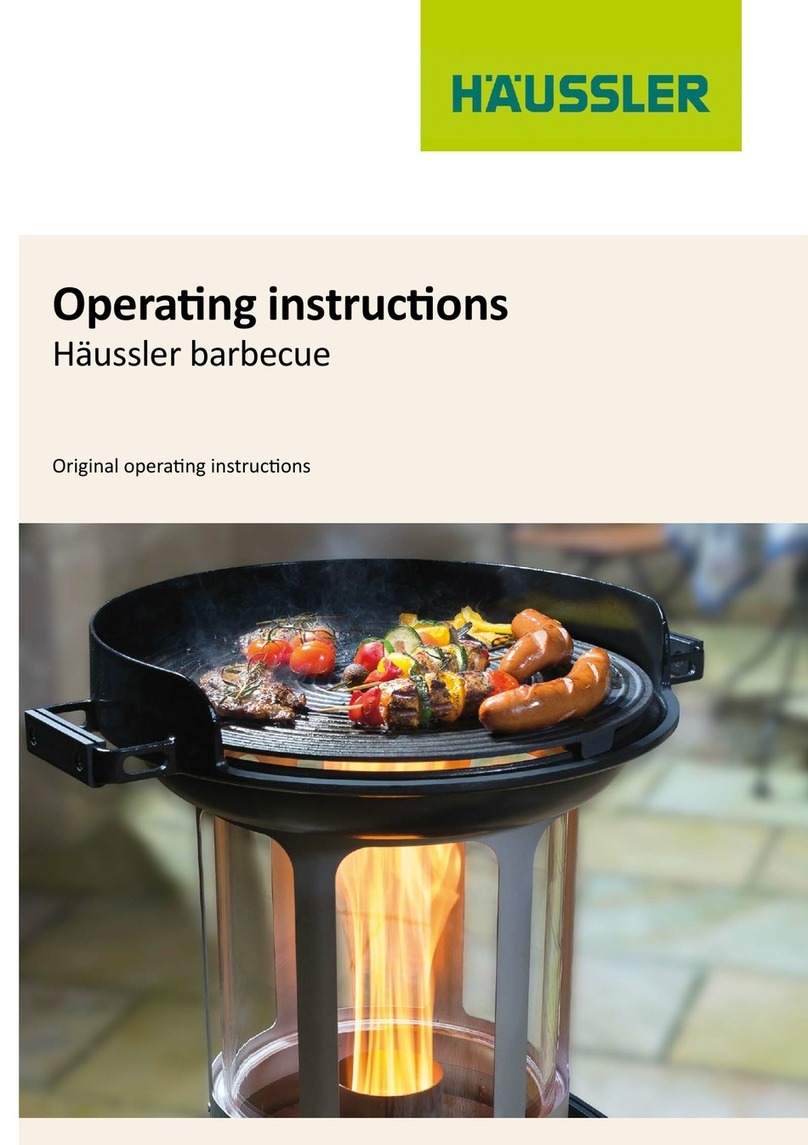
HAUSSLER
HAUSSLER Barbecue operating instructions
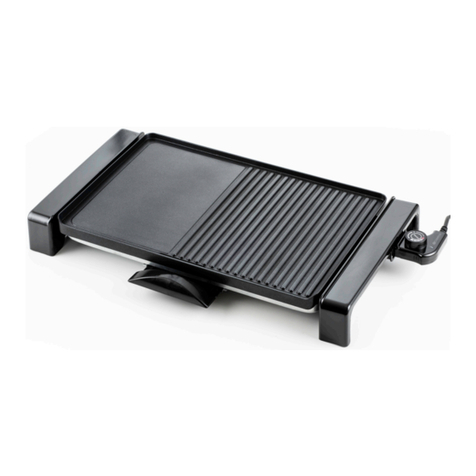
Champion
Champion CHEG210 user manual
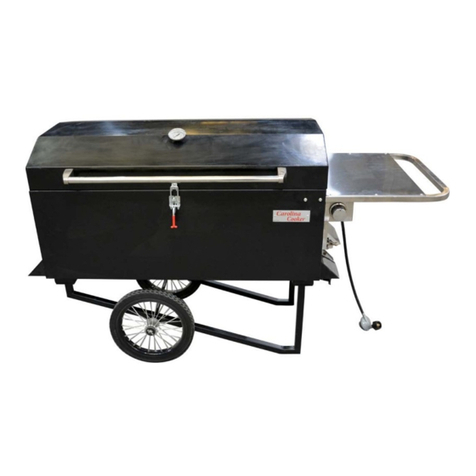
Carolina Cooker
Carolina Cooker M107828 owner's guide
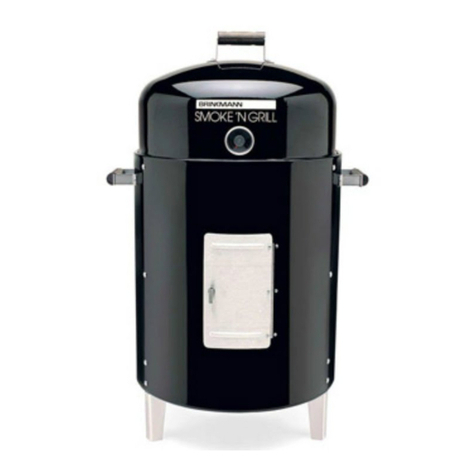
Brinkmann
Brinkmann DS-30 owner's manual

Brinkmann
Brinkmann SMOKE'N GRILL Owners manual assembly and operation instructions
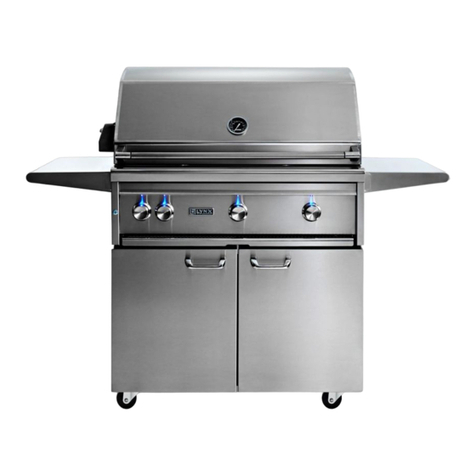
Lynx
Lynx ALL-TRIDENT L30ATRF Care & use/installation

